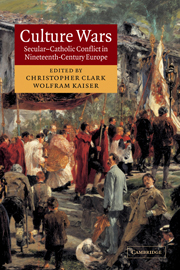Book contents
- Frontmatter
- Contents
- List of illustrations
- List of contributors
- Introduction: The European culture wars
- 1 The New Catholicism and the European culture wars
- 2 ‘Clericalism – that is our enemy!’: European anticlericalism and the culture wars
- 3 ‘Priest hits girl’: on the front line in the ‘war of the two Frances’
- 4 The battle for monasteries, cemeteries and schools: Belgium
- 5 Contested rituals and the battle for public space: the Netherlands
- 6 Nonconformity, clericalism and ‘Englishness’: the United Kingdom
- 7 The assault on the city of the Levites: Spain
- 8 Roma o morte: culture wars in Italy
- 9 Enemies at the gate: the Moabit Klostersturm and the Kulturkampf: Germany
- 10 Village quarrels and national controversies: Switzerland
- 11 The Counter-Reformation's last stand: Austria
- 12 The uncivil origins of civil marriage: Hungary
- Annotated bibliography
- Index
10 - Village quarrels and national controversies: Switzerland
Published online by Cambridge University Press: 23 July 2009
- Frontmatter
- Contents
- List of illustrations
- List of contributors
- Introduction: The European culture wars
- 1 The New Catholicism and the European culture wars
- 2 ‘Clericalism – that is our enemy!’: European anticlericalism and the culture wars
- 3 ‘Priest hits girl’: on the front line in the ‘war of the two Frances’
- 4 The battle for monasteries, cemeteries and schools: Belgium
- 5 Contested rituals and the battle for public space: the Netherlands
- 6 Nonconformity, clericalism and ‘Englishness’: the United Kingdom
- 7 The assault on the city of the Levites: Spain
- 8 Roma o morte: culture wars in Italy
- 9 Enemies at the gate: the Moabit Klostersturm and the Kulturkampf: Germany
- 10 Village quarrels and national controversies: Switzerland
- 11 The Counter-Reformation's last stand: Austria
- 12 The uncivil origins of civil marriage: Hungary
- Annotated bibliography
- Index
Summary
It is among the peculiarities of Swiss history in the nineteenth century that the struggle to establish a national state that was progressive and democratic by contemporary standards was bound up with various conflicts over religious policy. Within the protracted history of these conflicts, in which elements of a culture war can be discerned throughout, there is a period which is known more specifically as the Kulturkampf. It began with the First Vatican Council and was officially brought to an end around the middle of the 1880s. This Kulturkampf is the central concern of this chapter. Running parallel to the German Kulturkampf, it was an integral part of that fundamental confrontation between liberalism and ultramontane Catholicism that was waged in the second half of the nineteenth century in numerous European states. However, this was at the same time a conflict with genuinely Swiss roots, which was marked by the specific historic, political and confessional circumstances of the Swiss Confederation. Before we chart the course of the conflict, it therefore seems appropriate to point out those factors that lent the Kulturkampf in this part of Europe its specifically Swiss character.
TYPICALLY SWISS
We begin with the federal structure of Switzerland. The twenty-two cantons enjoyed a considerable degree of autonomy. Religious and cultural policy in particular remained within the responsibility of the cantons, even after the transition from a confederacy of states to a constitutionally unified federal state in 1848.
- Type
- Chapter
- Information
- Culture WarsSecular-Catholic Conflict in Nineteenth-Century Europe, pp. 255 - 284Publisher: Cambridge University PressPrint publication year: 2003
- 1
- Cited by

